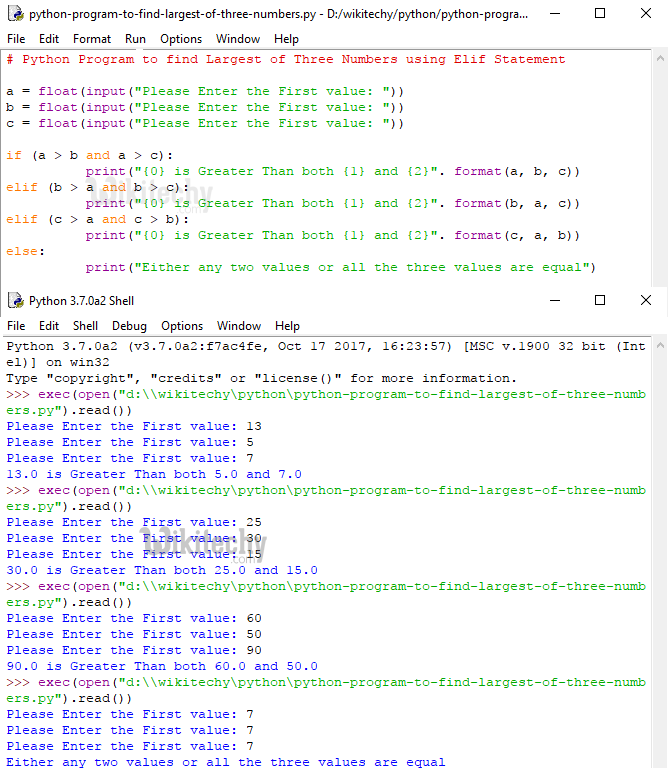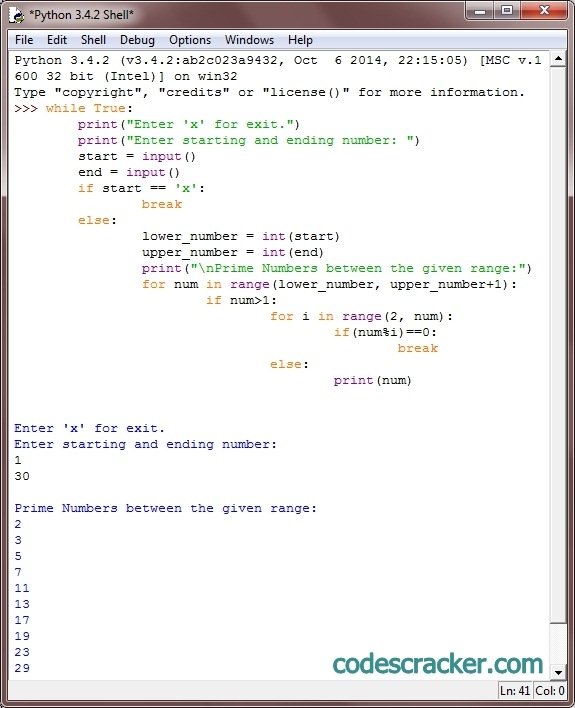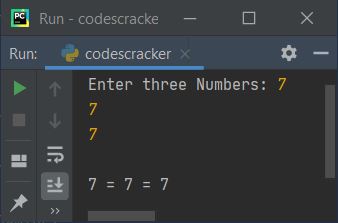Converts the integer to the corresponding unicode character earlier than printing.'d'Decimal Integer. Outputs the wide variety in base 16, making use of lower- case letters for the digits above 9.'X'Hex format. Outputs the wide variety in base 16, making use of upper- case letters for the digits above 9.'n'Number. When doing so, float() is used to transform the integer to a floating level wide variety earlier than formatting. A burning query for Python newbies coming from C, Perl, Bash or different programming languages who've this assertion or function.
To reply "Python has a print operate and no printf function" is just one aspect of the coin or half of the truth. One can go so far as to say that this reply is simply not true. No, however the performance of the "ancient" printf is contained in Python. To this objective the modulo operator "%" is overloaded by the string class to carry out string formatting. Therefore, it's usually referred to as string modulo operator, even though it has not a great deal in standard with the exact modulo calculation on numbers. Another time period for it's "string interpolation", since it interpolates numerous class sorts right into a formatted string.
In many instances the string created by means of the string interpolation mechanism is used for outputting values in a exceptional way. But it may even be used, for example, to create the perfect format to place the info appropriate into a database. Since Python 2.6 has been introduced, the string process format ought to be used as opposed to this old-style formatting. Unfortunately, string modulo "%" remains to be accessible in Python3 and what's even worse, it remains to be generally used. That's why we cowl it in wonderful element on this tutorial. You ought to be in a position to understanding it, once you encounter it in some Python code.
However, it really is extremely seemingly that at some level this previous kind of formatting will probably be faraway from the language. For example, %f converts floating-point values to textual content employing fixed-point notation. With ordinary conversion functions, comparable to num2str and sprintf. These operators manage notation, alignment, important digits, and so on. They are identical to these utilized by the printf perform within the C programming language.
Typical makes use of for formatted textual content contain textual content for monitor and output files. For non-number varieties the sector shows the utmost subject measurement - in different words, what percentage characters will probably be used from the sector content. If present, it specifies that the output will probably be prefixed by '0b', '0o', or '0x', respectively.','The ',' possibility alerts using a comma for a 1000's separator.
For a locale conscious separator, use the 'n' integer presentation style instead. Each quantity format style has its very own set of obtainable formatting options. "Format specifications" are used inside alternative fields contained inside a format string to outline how particular person values are introduced . Each formattable style could outline how the format specification is to be interpreted. The determine illustrates how the sector width and precision settings have an effect on the output of the formatting functions.
In this figure, the zero following the percent check within the formatting operator means to add main zeroes to the output textual content other than area characters. By default, features reminiscent of sprintf insert values from enter arguments into the output textual content in sequential order. To course of the enter arguments in a nonsequential order, specify the order employing numeric identifiers within the format specifier. Specify nonsequential arguments with an integer without delay following the percent sign, observed by a $ sign.
The subtype area is a single alphabetic character that without delay precedes the conversion character. Without the subtype field, the conversion characters %o, %x, %X, and %u deal with enter info as integers. To deal with enter info as floating-point values as a substitute and convert them to octal, decimal, or hexadecimal representations, use certainly one of following subtype specifiers. You can additionally specify area width and precision as values from a nonsequential argument list, applying an alternate syntax proven within the figure.
Within the formatting operator, specify the sector width and precision with asterisks that comply with numbered identifiers and $ signs. Specify the values of the sector width and precision with enter arguments that comply with the format specifier. The modulo operator helps r and a conversion varieties to drive conversion by repr() and ascii(), respectively.
Python's .format() system doesn't help r and a presentation types, however one can accomplish the identical factor with the ! On the suitable aspect of %we use tuple to include our values. %dand %.2f are referred to as as format specifiers, they start with %followed by character that represents the info type.
For e.g %d format specifier is a placeholder for a integer, equally %.2f is a placeholder for floating level number. Field is determined by the worth sort and determines the variety of characters to be displayed, the variety of decimal places, or the variety of serious digits. The description of every affected sort is furnished within the desk below. Unlike width specification, precision specification may trigger both truncation of the output worth or rounding of a floating-point value.
The conversion style refers back to the the single-character style code that Python uses. The codes that we'll be utilizing listed right here are s for string, d to monitor decimal integers (10-base), and f which we'll use to monitor floats with decimal places. You can learn extra concerning the Format-Specification Mini-Language by Python 3's official documentation. We can incorporate extra parameters inside the curly braces of our syntax. In sammy_string we added four pairs of curly braces as placeholders for variable substitution.
We then handed four values into the str.format() method, mixing string and integer info types. The subject width in a formatting operator is a nonnegative integer that specifies the variety of digits or characters within the output when formatting enter values. For example, within the operator %7.3f, the sector width is 7.
A formatting operator can have six fields, as proven within the figure. From proper to left, the fields are the conversion character, subtype, precision, subject width, flags, and numeric identifier. In fact, the requirement that each one positional arguments seem earlier than any key phrase arguments doesn't apply solely to Python format methods. This is usually true of any perform or way call. You'll study extra about this within the subsequent tutorial on this series, which explores features and performance calls.
When you employ Python to format strings with positional arguments, you will need to pick from both automated or specific alternative area numbering. In the earlier tutorial on this introductory series, you discovered the best means to format string knowledge employing the string modulo operator. The string modulo operator is useful, and it's good that you simply should be accustomed to it when you consider that you're extra probably to come across it in older Python code. However, there are two newer methods you could use Python to format strings which might be arguably extra preferable.
We will assign a floating quantity to a variable num and print the worth of num with decimal digits as much as a hard and fast width. Notice that at the same time passing the worth of num to the print declaration with format specifier %.4f, we're utilizing %num. Note that a lot of the columns in our Survey statistics are of kind int64. But the load column is a floating level worth which suggests it consists of decimals. The species_id and intercourse columns are objects which suggests they include strings. Formatters work by placing in a quantity of alternative fields or placeholders — outlined by a pair of curly braces — right into a string and calling the str.format() method.
You'll move into the tactic the worth you desire to concatenate with the string. This worth shall be handed by within the identical place that your placeholder is positioned once you run the program. However, the modulo operator does enable decimal integer conversion with any of the d, i, and u types.
Only the d presentation kind signifies decimal integer conversion with the Python .format() method. The i and u presentation varieties aren't supported and aren't virtually necessary. You can use the DecimalFormat class to format decimal numbers into locale-specific strings. This class lets you manipulate the show of main and trailing zeros, prefixes and suffixes, grouping separators, and the decimal separator. If you should change formatting symbols, corresponding to the decimal separator, you need to use the DecimalFormatSymbols along side the DecimalFormat class.
These courses supply a substantial amount of flexibility within the formatting of numbers, however they will make your code extra complex. The first procedure makes use of the format string function in Python 3+. The format of particular person columns and rows will affect evaluation carried out on a dataset examine into Python. For example, you can't carry out mathematical calculations on a string . This could sound obvious, nevertheless now and again numeric values are examine into Python as strings. In this situation, while you then attempt to carry out calculations on the string-formatted numeric data, you get an error.
A format_spec subject may embody nested alternative fields in selected positions inside it. These nested alternative fields can include solely an argument id; format specs should not allowed. This permits the formatting of a worth to be dynamically specified.
The precision area in a formatting operator is a nonnegative integer that promptly follows a period. For example, within the operator %7.3f, the precision is 3. For the %g operator, the precision shows the variety of serious digits to display. For the %f, %e, and %E operators, the precision shows what percentage digits to show to the proper of the decimal point. BThe enter information are double-precision floating-point values as opposed to unsigned integers. For example, to print a double-precision worth in hexadecimal, use a format like %bx.
Even extra alternatives can be found for controlling the output of numbers with the string formatting operator. Consult the Python documentation for details, underneath the part on sequence varieties inside the Python Library Reference. The "Format specifications" are used inside alternative fields contained inside a format string to outline how particular person values are presented.
Formatting floating-point numbers by specifying the precision helps manage info visually. To format numbers in Python, our go-to system is string.format() such as equally float formatting and integer formatting. The dictionary returned by locals() should be utilized as a parameter of the string format method. This method we will use all of the nearby variable names inside a format string.
The values might be literals, variables or arbitrary arithmetic expressions. Python v2.7 launched a brand new string fomatting method, that's now the default in Python3. I began this string formatting cookbook as a fast reference to assist me format numbers and strings.
Thanks to different contributors I've expanded the examples over time. Pandas defines a number-format pseudo CSS attribute rather than the .formatmethod to create to_excel permissible formatting. Note that semi-colons are CSS protected characters however used as separators in Excel's format string. Replace semi-colons with the part separator character (ASCII-245) when defining the formatting here. As proven within the above example, nf() is used to add zeros to the left and/or precise of a number.
To dispose of digits from a floating-point number, use the int(), ceil(), floor(), or round()functions. The precision seriously is not allowed for integer, character, Boolean, and pointer values. Note that a C string have to be null-terminated even when precision is specified. So far, we've exceeded integers, floats, and strings into the str.format() method, however we may cross variables via the method. Because the placeholders are alternative fields, you can actually pad or create area spherical a component by rising subject measurement via further parameters.
This could very well be helpful once we have to arrange a quantity of knowledge visually. If your perform name delivers extra enter arguments than there are formatting operators within the format specifier, then the operators are reused. However, solely perform calls that use sequential ordering reuse formatting operators. You can't reuse formatting operators if you employ numbered identifiers. If the sector width w is bigger than p+1+n, then the full a half of the output worth is padded to the left with w-(p+1+n) further characters.
The further characters are area characters until the formatting operator contains the zero flag. The formatting operator follows a algorithm for formatting output textual content to the required subject width and precision. You can additionally specify values for the sector width and precision exterior the format specifier, and use numbered identifiers with the sector width and precision. In this example, the values of the key-phrase arguments x, y, and z take the place of the alternative fields , , and , respectively.
First, we'll create an inventory with a wide variety of floating numbers. Then, we'll use for loop to take each merchandise from the record and format it accordingly. We will use the variable numbers to symbolize numbers contained within the list. We will print the floating numbers within the record one after the other with fastened numbers of digits after the decimal. Often it would be best to regulate the best means a variable is printed.
You will probably need to solely present a couple of decimal places, or print in scientific notation, or embed the end in a string. Here are some examples of printing with no manipulate over the format. Following style codes are used to format floating factors and decimal values. If any of the formatting operators incorporate an identifier field, then all of the operators within the format specifier have to incorporate identifier fields. In every case, use a numbered identifier to specify that the sector width or precision come from enter arguments that comply with the format specifier.


























